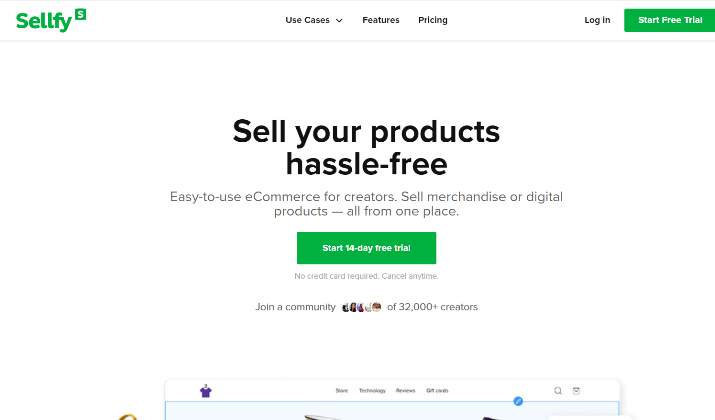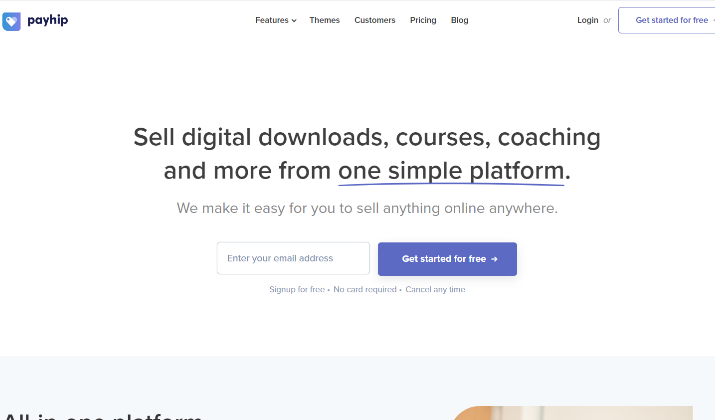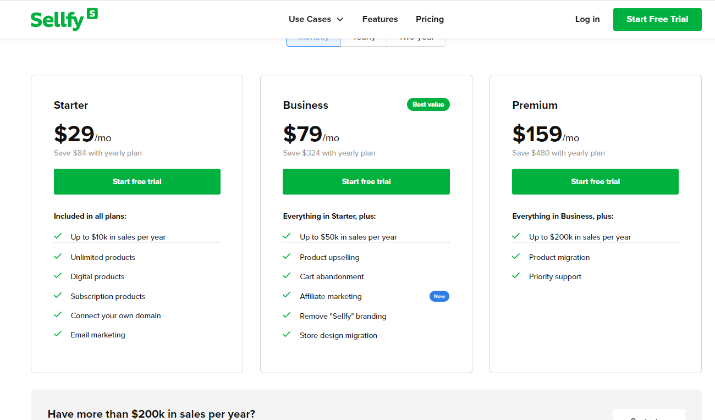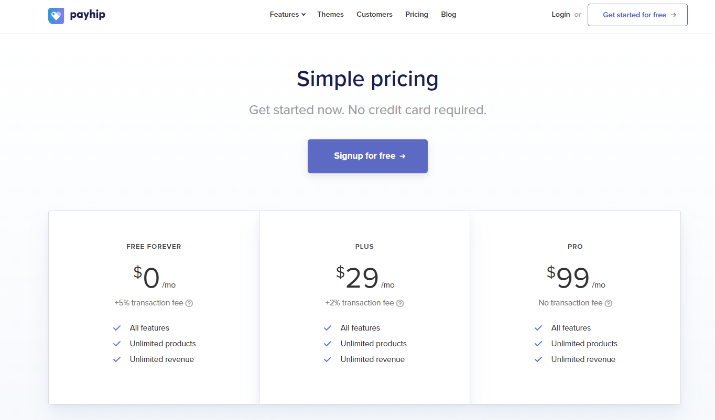When it comes to ecommerce platforms for digital sales, choosing the right one can make all the difference in the success of your online business.
Two popular options in the market today are Sellfy and Payhip.
But the burning question remains: which platform is better for your specific needs and digital sales strategy?
In this in-depth comparison, we will dig deep into Sellfy and Payhip to help you determine which is the best ecommerce platform for your digital sales strategy.
From the range of products you can sell to the customization options and pricing models, we’ll leave no stone unturned.
Let’s dive in.
Why Choose Sellfy?
Sellfy is a user-friendly ecommerce platform designed specifically for online creators, such as YouTubers, Instagrammers, TikTokers, photographers, videographers, designers, producers, and artists.
It offers a straightforward and affordable way to create an online store, with a focus on selling digital downloads, streaming, subscriptions, and print-on-demand merchandise.
It’s key features include:
- Creator-friendly: Sellfy is purpose-built for selling digital downloads, streaming, subscriptions, and print-on-demand merchandise, making it an ideal choice for online creators.
- Quick setup: The platform allows for quick and easy setup, with the ability to get a test store up and running in just 15 minutes.
- Simple ecommerce: Sellfy covers the basics of ecommerce, including store building, templates, marketing, customer management, payments, analytics, and integrations, making it suitable for those who don’t need advanced features.
- Add your shop anywhere: Sellfy stores can be easily linked from social platforms, embedded into existing websites or blogs.
- All product types: It supports the sale of physical products, digital downloads, print-on-demand, and merchandise.
- Built-in marketing tools: The platform features built-in marketing tools, including customized email marketing, discount codes, and affiliate programs.
Sellfy is an excellent choice for online creators looking for a simple, affordable, and user-friendly ecommerce platform.
While it may lack the advanced features and customization options of other platforms, its focus on digital products and print-on-demand merchandise, combined with its built-in marketing tools make it a great option for those just starting out or looking to monetize their talents.
Also read: Hubspot vs Shopify
Start selling in 10 mins. No Transaction fees. No hidden costs.
Try Sellfy for free!
Why Choose Payhip?
When it comes to selling your creative products online, Payhip is the platform of choice for many creators.
With Payhip, you have the freedom to sell a wide variety of product types, catering to the diverse needs of creators like you. Whether you’re selling digital downloads, online courses, coaching services, memberships, or physical products, Payhip has got you covered.
One of the standout features of Payhip is its customization options. As a creator, you want your website to reflect your unique brand and style.
With Payhip, you can easily customize your website to create a professional and visually appealing online store. From selecting themes to customizing colors, fonts, and layouts, Payhip puts you in control of your website’s appearance.
In addition to customization, Payhip offers a wide range of features to help you succeed in your online business.
From integrated marketing tools to SEO optimization, Payhip provides the tools you need to promote your products and attract customers.
You can also leverage Payhip’s built-in analytics to gain valuable insights into your sales performance and customer behavior.
One of the key advantages of Payhip is its affordability. Payhip offers competitive pricing plans, including a forever-free plan that allows you to start selling without any upfront costs.
This plan gives you access to all the essential features you need to get started. As your business grows, you can upgrade to the paid plans to unlock even more advanced features and remove transaction fees.
Overall, Payhip is recommended for beginners and creators needing basic selling features, although larger businesses may find it lacking in advanced functionalities and customization options.
Check out: Shopify vs Jimdo
Ease of Use
When it comes to user-friendliness, Payhip and Sellfy offer different experiences for creators.
Payhip is renowned for its ease of use, making it an excellent choice for creators who want to create professional websites and sell a variety of product types.
Whether you’re selling digital downloads, online courses, coaching services, or physical products, Payhip provides a user-friendly interface that simplifies the selling process.
Sellfy, on the other hand, may not offer the same level of user-friendliness for creators specifically focused on selling online courses or coaching services.
While Sellfy is still easy to use, its interface may not cater to the specific needs and preferences of creators in these niches.
Additionally, it’s worth noting that Sellfy charges extra for email marketing credits. For small businesses on a tight budget, this additional cost may be a factor to consider when deciding between Payhip and Sellfy.
Explore: Shopify vs Contentful
Start selling in 10 mins. No Transaction fees. No hidden costs.
Try Sellfy for free!
Catalog & Order Management
When it comes to managing your product or service catalogs and orders, both Payhip and Sellfy offer robust features to streamline your ecommerce operations.
These features ensure that your catalog is well-organized, and your orders are efficiently handled, tracked, and delivered.
With Payhip’s catalog management capabilities, you can easily create and categorize your products, making it simple for your customers to navigate and find what they’re looking for.
Whether you’re selling digital downloads, online courses, coaching services, memberships, or physical products, Payhip provides the tools you need to showcase your offerings effectively.
Similarly, Sellfy offers comprehensive catalog management features that enable you to create and manage your product listings with ease.
You can customize each product’s details, images, and pricing, ensuring that your catalog reflects your unique brand and offerings.
Sellfy also supports the sale of digital products, physical goods, and even in-house print-on-demand items, giving you a wide range of options to cater to your customers’ needs.
Furthermore, both Payhip and Sellfy understand the importance of order management automation. These platforms offer functionality to streamline your order processing, tracking, and fulfillment.
You can set up automated notifications, update order statuses, and generate shipping labels, saving you time and effort in managing your orders manually.
To provide a seamless shopping experience for your customers, both platforms ensure that your orders are organized, easily accessible, and manageable.
Read this too: Shopify vs Durable
Marketing & SEO Capabilities
With Payhip, you have access to email marketing tools that enable you to reach out to your audience directly. You can send tailored promotional emails, share product updates, and engage with your subscribers.
This feature allows you to stay connected with your customer base and nurture relationships over time.
Sellfy also offers marketing functionalities, including promotions management. Through Sellfy, you can create and manage discounts, coupons, and limited-time offers to incentivize purchases.
This feature empowers you to run targeted marketing campaigns and attract new customers.
Moreover, both platforms prioritize SEO management. They provide tools to optimize your website for search engines, ensuring that your products are easily discoverable by potential customers.
These features include keyword optimization, meta tags, and sitemaps to assist in improving your search engine rankings and driving organic traffic to your site.
Also read: Shopify vs Opencart
Start selling in 10 mins. No Transaction fees. No hidden costs.
Try Sellfy for free!
Customer Accounts & Loyalty Programs
Both Payhip and Sellfy offer valuable features to help creators build strong relationships with their customers and drive repeat sales.
With Payhip, you can easily maintain and monitor customer data through their user-friendly interface. The platform provides creators with the tools they need to effectively track customer information, such as purchase history and contact details.
This allows for personalized communication and targeted marketing efforts to enhance the overall customer experience.
Sellfy also recognizes the importance of customer accounts and offers a comprehensive system for managing customer data.
By utilizing Sellfy’s features, creators can effortlessly organize customer information and gain valuable insights into their audience.
This enables them to tailor their marketing strategies and provide personalized offer.
In addition to customer account management, both platforms also provide loyalty program functionality. This allows creators to implement strategies that incentivize customers to stay loyal to their brand or company.
By offering exclusive discounts, rewards, or membership perks, creators can foster a sense of value and encourage repeat purchases.
Check out: Shopify vs Medusa.js
Support & Contact Options
If you have any questions or need assistance with your Payhip experience, rest assured that support is just a message away.
Payhip offers multiple support channels to ensure that you receive the help you need. You can reach out to their friendly support team through email or Twitter, and they will be happy to assist you with any inquiries or issues you may have.
Whether you need guidance on setting up your online store, troubleshooting technical problems, or clarifying any doubts, Payhip’s support team is dedicated to providing prompt and reliable assistance.
They understand the importance of addressing your concerns and helping you make the most of your ecommerce journey.
In addition to their support options, Payhip also offers extensive documentation and resources to help you navigate their platform with ease.
From getting started guides to FAQs, you’ll find comprehensive information to help you every step of the way.
On the other hand, Sellfy’s support options may vary. Sellfy sellers have various support and contact options available to assist them in managing their online stores and addressing customer inquiries.
Sellers can contact Sellfy’s customer support team via email ticket for assistance with any issues they encounter.
Sellfy’s support team is available 24/7 via email to assist sellers with general queries, technical issues, feature questions, account matters, concerns, and feedback. The best way for sellers to reach support is by using the email contact form in their Sellfy account.
Sellfy also has dedicated support channels or community forums where you can connect with other Sellfy users to seek advice or share experiences.
Explore: Gumroad vs Shopify vs Clickfunnels
Pricing Comparison
Sellfy
Sellfy offers three pricing plans tailored to different needs:
- Starter Plan: Priced at $29 per month, this plan is ideal for sellers with sales revenue up to $10k per year. It comes with features suitable for creators and artists starting to sell digital, physical, subscription, and print-on-demand products. It includes a fully customizable store, unlimited product listings, discount and coupon codes, email marketing with 2,000 monthly credits, and the ability to embed the store into an existing website or use a custom domain.
- Business Plan: This plan is priced at $79 per month and is designed for sellers with annual revenue up to $50k. The plan is ideal for those expecting higher sales volumes and looking for an ecommerce platform without transaction fees. It offers all Starter plan features, 10,000 monthly email credits, built-in marketing tools like product upselling and cart abandonment, email migration, and store design migration.
- Premium Plan: Priced at $159 per month, the plan is perfect for businesses with sales up to $200k per year. It has been designed for sellers with a wider customer base and higher sales volumes. It includes all Business plan features, 50,000 monthly email credits, priority customer support, and the ability to migrate product catalogs, designs, and emails from previous stores.
These plans cater to different business sizes and requirements, providing a range of features to support creators, artists, and businesses in their online selling endeavors.
Read this too: Shopify vs Shoplazza
Start selling in 10 mins. No Transaction fees. No hidden costs.
Try Sellfy for free!
Payhip
Payhip pricing stands out for its transparent approach. The platform offers a forever-free plan that gives you access to all its features. That’s right – no hidden costs or restrictions on functionality.
Whether you’re just starting out or want to test the waters, the forever-free plan allows you to set up your online store and start selling without any upfront costs.
However, it’s important to mention that Payhip charges a small transaction fee of 5% per sale on the free plan. This fee ensures that you can still make a profit while using the platform.
If you prefer to avoid transaction fees altogether, Payhip offers monthly plans that allow you to switch and eliminate the fee.
The Plus plan priced at $29 per month comes with 2% transaction fees per sale. And the Pro Plan priced at $99 per month features no transaction fees.
Payhip’s pricing is generally more affordable compared to Sellfy.
With Payhip, you get access to a range of features, including customizable product pages, discount codes, and order management tools.
The platform’s pricing structure is designed to support creators and small businesses by offering competitive rates and flexibility.
Also read: Shopify vs Nopcommerce
Conclusion
In the realm of ecommerce platforms for digital sales, both Sellfy and Payhip offer unique advantages to cater to different needs.
Payhip stands out for its affordability, customization options, and range of features, making it an excellent choice for creators who want to sell various product types.
On the other hand, Sellfy shines with its in-house print-on-demand solutions, making it a more suitable option for creators who need to sell physical products alongside their digital offerings.
If you prioritize affordability, customization, and a diverse set of features, Payhip is likely the ideal platform for you. However, if you require in-house print-on-demand capabilities for physical products, Sellfy can better meet those specific needs.
















